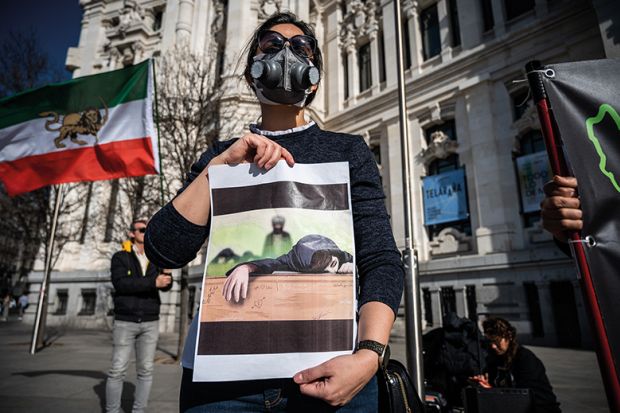Recent months have marked one of the most traumatic times in the history of women’s education in Iran. Almost every day we have seen images of ambulances in front of girls’ education centres and of female school and college students lying on hospital beds.
This all started about five months ago with a couple of reports of girls being poisoned in certain schools in Qom – apparently by chemical gas attacks. These harrowing incidents occurred in the midst of the “Women, Life, Freedom” protests, sparked by the death in police custody of a woman arrested for not wearing an approved hijab, and the timing led many people to believe the attacks were intended as revenge for the protests – or perhaps as a distraction from them.
By now, hundreds of girls’ schools throughout the country have experienced poisonings; so too have women’s dormitories at several universities – including, most recently, the University of Tehran. If that wasn’t disturbing enough already, a series of mass food poisonings have also occurred at several universities.
Some attribute the attacks to ultra-conservative elements in the government. Others, noting that Qom is the headquarters of the Shiite clergy, blame radical religious groups. Despite public demands, there has still been no clear explanation from the authorities. Indeed, only a few of the attacks have been officially confirmed, with the rest attributed to mass hysteria or malingering and mischief on the part of students. This information vacuum has sparked a new wave of protests, including on campuses.
According to news reports, a March protest at Allameh Tabataba’i University against mass poisonings resulted in clashes with university security; more than 30 students who took part were later banned from the university. More recently, in reaction to poison attacks on several schools in the city of Shahin Shar, people protested in front of the local government education department, before the protest was shut down by police.
No one knows how long the attacks will go on, but they are already having a negative effect on women’s education. Girls are afraid to go to school and university, and many people have even asked for a temporary closure of girls’ schools for the sake of their safety. Some families have decided to stop sending their girls to school until the danger subsides.
Women’s education has always been contentious in Iran. Official education for Iranian women dates from 1907, when the first girls’ school was founded in Tehran. Schools were soon established in other big cities, too, but radical elements in the clergy reacted with hostility and physical attacks, and the status of women’s education remained precarious until the Pahlavi dynasty assumed power in 1925. This authoritarian but secular regime provided suitable conditions for women’s education, culminating in women entering the University of Tehran, the country’s first modern university, soon after its foundation in 1934.
But the rapid process of modernisation in a still highly traditional and religious society created tension. Women’s freedom needed official protection, not only against public harassment by radical groups and street troublemakers, but also against traditional patriarchy inside families. That need for robust pushback is often cited as the reason why the hijab was not only discouraged as backward but was also even banned for a few years.
Such precipitous modernisation, in turn, is often seen as the reason for the Islamic revolution of 1979. Within two years, Ayatollah Khomeini closed all universities on the grounds that they were too highly politicised. However, the ultimate aim of the so-called Cultural Revolution was to “domesticate” institutions that some revolutionists saw as too Westernised.
Eventually, universities reopened, but women were barred from some of them, as well as from certain scientific fields, including some branches of engineering. Furthermore, many women were deprived of their professorship positions. Some radical groups asked for complete gender segregation inside universities, including lectures, but there were not enough professors to teach so many extra classes.
Despite the restrictions, female enrolment in universities continued to grow, until women began to outnumber men in many fields. Officially, about 60 per cent of current university students in Iran are female. Some researchers believe that the Cultural Revolution – the Islamisation of the public sphere – gained universities the trust of traditional, religious families.
However, although some officials see the rise of female education as a remarkable development, there has always been a negative attitude towards it in some parts of the government. From time to time, this has shown up in policy, such as 2012’s prohibition of women studying 77 scientific fields at 36 universities.
Public support for women’s freedom is currently higher than perhaps at any time in contemporary Iranian history. Nevertheless, women’s recent displays of freedom in public areas, such as removing their hijabs, has probably backfired for women’s rights. The clampdown on officially controllable areas, such as schools, universities, offices and even subway stations, might be intensified.
The authorities have emphasised that disobedient female students will be deprived of education, and numerous college students have received text messages warning them about how they dress. Some campuses are reported to be garrisoned, with surveillance cameras set up in every corner – even within women’s dormitories.
As the Taliban radically restricts women’s education in Iran’s eastern neighbour Afghanistan, in defiance of both domestic and international pressure, it is vital to defend it in Iran – and academia should be at the forefront of that effort. We must not let fear poison our resolve to build on more than a century of hard-won gains.
Roohola Ramezani has a PhD in philosophy from Shahid Beheshti University, Tehran. He has been a research fellow at the IFK International Research Centre for Cultural Studies in Vienna. His research interests include various topics in science studies, social epistemology and Iranian studies.




